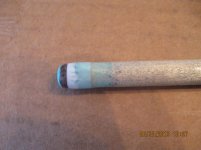I wonder why does a shaft which is sealed and waxed still collects chalk residue and gets blue?
When I cleaned/sealed/waxed my new shaft I was hoping it won't get dirty, especially provided I wipe the shaft with a towel during play to keep chalk dust away. But it is very easy to tell my shaft from a new and untouched one.
I'm aware wax goes off with time and needs to be renewed, but what about the sealer? Wood grain is supposed to be covered and not allow any chalk in. Maybe chalk gets not into wood but in tiny scratches in sealer (which are inevitable even after sanding with 1200 grip paper I suppose)?
Mind you, I do professional cue repairs and do my homework, so there is no technical issues with the way I seal the shaft.
When I cleaned/sealed/waxed my new shaft I was hoping it won't get dirty, especially provided I wipe the shaft with a towel during play to keep chalk dust away. But it is very easy to tell my shaft from a new and untouched one.
I'm aware wax goes off with time and needs to be renewed, but what about the sealer? Wood grain is supposed to be covered and not allow any chalk in. Maybe chalk gets not into wood but in tiny scratches in sealer (which are inevitable even after sanding with 1200 grip paper I suppose)?
Mind you, I do professional cue repairs and do my homework, so there is no technical issues with the way I seal the shaft.
